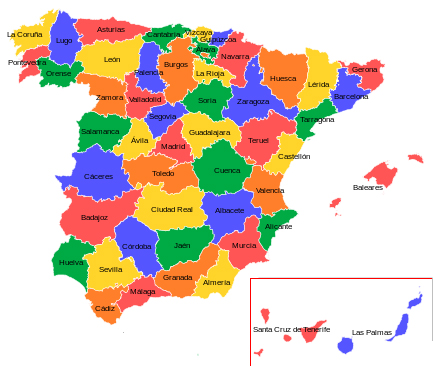Spanish Provinces and their Capitals
Spain and its autonomous communities are divided into fifty provinces each with its own capital city which usually, but not always, carries the same name as the province. Ceuta, Melilla and the Plazas de soberanía are not part of any provinces.
The layout of Spain's provinces closely follows the pattern of the territorial division of the country carried out in 1833. The only major change of provincial borders since that time has been the subdivision of the Canary Islands into two provinces rather than one.

Historically, the provinces served mainly as transmission belts for policies enacted in Madrid, as Spain was a highly centralised state for most of its modern history. The importance of the provinces has declined since the adoption of the system of autonomous communities in the period of the Spanish transition to democracy. They nevertheless remain electoral districts for national elections and as geographical references: for instance in postal addresses and telephone codes.
A small town would normally be identified as being in, say, Valladolid province rather than the autonomous community of Castile and León. The provinces were the "building-blocks" from which the autonomous communities were created. Consequently, no province is divided between more than one of these communities.
Most of the provinces - with the exception of Álava/Araba, Asturias/Asturies, Bizkaia/Vizcaya, Cantabria, Gipuzkoa/Gipúzcoa, Illes Balears/Islas Baleares, La Rioja, and Nafarroa/Navarra - are named after their principal town. Only two capitals of autonomous communities - Mérida in Extremadura and Santiago de Compostela in Galicia - are not also the capitals of provinces.
Seven of the autonomous communities comprise no more than one province each: Asturias, Balearic Islands, Cantabria, La Rioja, Madrid, Murcia, and Navarra. These are sometimes referred to as "uniprovincial" communities.


